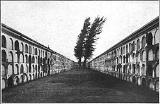
Espada Cemetery
Encyclopedia
The Espada Cemetery is a disused cemetery
located approximately a mile west of the city of Havana, Cuba, near to the coast and close to the San Lázaro Leper Hospital. In use from 1806 to 1878, the Espada Cemetery was the first burial place formally designed and constructed in the Havana region; prior to the cemetery construction, the Havana custom had been to bury the dead in vaults
of the Churches. It was named after the Bishop
incumbent at the time of design, José Díaz de Espada y Landa. Its boundaries included the present streets of San Lázaro, Vapor, Espada, and Aramburu. Despite being officially called Campo Santo (Holy Field), the general populace of Havana typically referred to the cemetery as el cementerio Espada (the Espada Cemetery).
 The cemetery was used as the primary burial ground for the city of Havana from 1806 until the late 1860s. In 1868, a cholera
The cemetery was used as the primary burial ground for the city of Havana from 1806 until the late 1860s. In 1868, a cholera
epidemic
broke out in the area, resulting in a greatly increased rate of death. It soon became apparent that the Espada Cemetery, still the only major burial ground in the region, would not suffice to handle the number of deaths that were coming from the epidemic. To compound matters, the reformist El Siglo scorned the Espada Cemetery in an 1865 editorial as unworthy of "the most miserable village." One United States visitor, after returning from a sobering tour of Havana's Espada cemetery at that time, instructed his hotel's attendant that if he were to die on the island, he must be buried at sea. In order to supplement the struggling Espada Cemetery, another cemetery, the Colón Cemetery , named for explorer Christopher Columbus
, was inaugrated in 1871. In 1878, the Espada Cemetery was closed in favour of the larger Colón Cemetery and because of the lack of space still remaining within the Espada Cemetery grounds. The Colón Cemetery remains in active use today, and now harbours more than 800,000 corpses.
Cemetery
A cemetery is a place in which dead bodies and cremated remains are buried. The term "cemetery" implies that the land is specifically designated as a burying ground. Cemeteries in the Western world are where the final ceremonies of death are observed...
located approximately a mile west of the city of Havana, Cuba, near to the coast and close to the San Lázaro Leper Hospital. In use from 1806 to 1878, the Espada Cemetery was the first burial place formally designed and constructed in the Havana region; prior to the cemetery construction, the Havana custom had been to bury the dead in vaults
Burial vault (tomb)
A burial vault is a structural underground tomb.It is a stone or brick-lined underground space or 'burial' chamber for the interment of a dead body or bodies. They were originally and are still often vaulted and usually have stone slab entrances...
of the Churches. It was named after the Bishop
Bishop
A bishop is an ordained or consecrated member of the Christian clergy who is generally entrusted with a position of authority and oversight. Within the Catholic Church, Eastern Orthodox, Oriental Orthodox Churches, in the Assyrian Church of the East, in the Independent Catholic Churches, and in the...
incumbent at the time of design, José Díaz de Espada y Landa. Its boundaries included the present streets of San Lázaro, Vapor, Espada, and Aramburu. Despite being officially called Campo Santo (Holy Field), the general populace of Havana typically referred to the cemetery as el cementerio Espada (the Espada Cemetery).
History
The cemetery was built in response to population growth around the area, and the resulting scarcity of church land that could be used for burial. It was proposed and sanctioned by the government of Don Salvador de Muro y Salazar in 1804, and, after two years of design and construction, the cemetery was ready for use in 1806, and was inaugurated on February 2 of that year.
Cholera
Cholera is an infection of the small intestine that is caused by the bacterium Vibrio cholerae. The main symptoms are profuse watery diarrhea and vomiting. Transmission occurs primarily by drinking or eating water or food that has been contaminated by the diarrhea of an infected person or the feces...
epidemic
Epidemic
In epidemiology, an epidemic , occurs when new cases of a certain disease, in a given human population, and during a given period, substantially exceed what is expected based on recent experience...
broke out in the area, resulting in a greatly increased rate of death. It soon became apparent that the Espada Cemetery, still the only major burial ground in the region, would not suffice to handle the number of deaths that were coming from the epidemic. To compound matters, the reformist El Siglo scorned the Espada Cemetery in an 1865 editorial as unworthy of "the most miserable village." One United States visitor, after returning from a sobering tour of Havana's Espada cemetery at that time, instructed his hotel's attendant that if he were to die on the island, he must be buried at sea. In order to supplement the struggling Espada Cemetery, another cemetery, the Colón Cemetery , named for explorer Christopher Columbus
Christopher Columbus
Christopher Columbus was an explorer, colonizer, and navigator, born in the Republic of Genoa, in northwestern Italy. Under the auspices of the Catholic Monarchs of Spain, he completed four voyages across the Atlantic Ocean that led to general European awareness of the American continents in the...
, was inaugrated in 1871. In 1878, the Espada Cemetery was closed in favour of the larger Colón Cemetery and because of the lack of space still remaining within the Espada Cemetery grounds. The Colón Cemetery remains in active use today, and now harbours more than 800,000 corpses.

